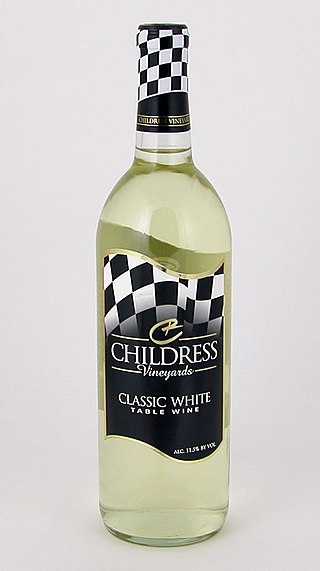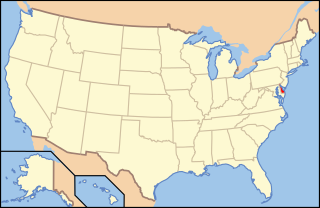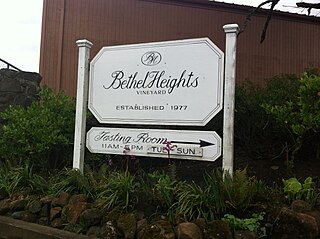
Cabernet Sauvignon is one of the world's most widely recognized red wine grape varieties. It is grown in nearly every major wine producing country among a diverse spectrum of climates from Australia and British Columbia, Canada to Lebanon's Beqaa Valley. Cabernet Sauvignon became internationally recognized through its prominence in Bordeaux wines, where it is often blended with Merlot and Cabernet Franc. From France and Spain, the grape spread across Europe and to the New World where it found new homes in places like California's Santa Cruz Mountains, Paso Robles, Napa Valley, New Zealand's Hawke's Bay, South Africa's Stellenbosch region, Australia's Margaret River, McLaren Vale and Coonawarra regions, and Chile's Maipo Valley and Colchagua. For most of the 20th century, it was the world's most widely planted premium red wine grape until it was surpassed by Merlot in the 1990s. However, by 2015, Cabernet Sauvignon had once again become the most widely planted wine grape, with a total of 341,000 hectares (3,410 km2) under vine worldwide.

Cabernet Franc is one of the major black grape varieties worldwide. It is principally grown for blending with Cabernet Sauvignon and Merlot in the Bordeaux style, but can also be vinified alone, as in the Loire's Chinon. In addition to being used in blends and produced as a varietal in Canada and the United States, it is sometimes made into ice wine in those regions.

Argentina is the fifth largest producer of wine in the world. Argentine wine, as with some aspects of Argentine cuisine, has its roots in Spain. During the Spanish colonization of the Americas, vine cuttings were brought to Santiago del Estero in 1557, and the cultivation of the grape and wine production stretched first to neighboring regions, and then to other parts of the country.

New Zealand wine is produced in several of its distinct winegrowing regions. As an island country in the South Pacific Ocean, New Zealand has a largely maritime climate, although its elongated geography produces considerable regional variation from north to south. Like many other New World wines, New Zealand wine is usually produced and labelled as single varietal wines, or if blended, winemakers list the varietal components on the label. New Zealand is best known for its Marlborough Sauvignon Blanc, and more recently its dense, concentrated Pinot Noir from Marlborough, Martinborough and Central Otago.

Washington wine is a wine produced from grape varieties grown in the U.S. state of Washington. Washington ranks second in the United States in the production of wine. By 2017, the state had over 55,000 acres (220 km2) of vineyards, a harvest of 229,000 short tons (208,000 t) of grapes, and exports going to over 40 countries around the world from the 940+ wineries located in the state. While there are some viticultural activities in the cooler, wetter western half of the state, the majority (99.9%) of wine grape production takes place in the shrub-steppe eastern half. The rain shadow of the Cascade Range leaves the Columbia River Basin with around 8 inches (200 mm) of annual rain fall, making irrigation and water rights of paramount interest to the Washington wine industry. Viticulture in the state is also influenced by long sunlight hours and consistent temperatures.
The state of Oregon in the United States has established an international reputation for its production of wine, ranking fourth in the country behind California, Washington, and New York. Oregon has several different growing regions within the state's borders that are well-suited to the cultivation of grapes; additional regions straddle the border between Oregon and the states of Washington and Idaho. Wine making dates back to pioneer times in the 1840s, with commercial production beginning in the 1960s.

The Red Mountain AVA is an American Viticultural Area that includes the land surrounding Red Mountain in Benton County, Washington. It is part of the Yakima Valley AVA, which in turn is part of the larger Columbia Valley AVA. Located between Benton City and the City of West Richland, the Red Mountain AVA is the smallest in the state at only 4,040 acres (1,630 ha) in area. The area has more than 2,000 acres (810 ha) under cultivation of primarily red varietals including Cabernet Sauvignon, Merlot, Sangiovese, Cabernet Franc and Syrah. The reputation of the wines produced in this area has brought Red Mountain AVA worldwide acclaim. The vineyards in this appellation have produced grapes for some of the most sought after wines in Washington State.
Napa Valley is an American Viticultural Area (AVA) located in Napa County in California's Wine Country. It was established by the Bureau of Alcohol, Tobacco and Firearms (ATF) on January 27, 1981. Napa Valley is considered one of the premier wine regions in the world. Records of commercial wine production in the region date back to the nineteenth century, but premium wine production dates back only to the 1960s.

Childress Vineyards is a winery in Lexington, North Carolina owned by NASCAR Cup Series championship team owner Richard Childress. The connection between NASCAR and fine wine is reflected in the labeling of some of the wines produced by Childress, featuring a checkered flag motif.

Barboursville Vineyards is a winery located in the Piedmont region of the Commonwealth of Virginia in the unincorporated community of Barboursville, Virginia. It is located within both the Virginia and Monticello viticultural areas.

The Oakville AVA is an American Viticultural Area located within Napa Valley AVA and centered on the town of Oakville, California. The appellation extends over a flat expanse of well-drained gravel soil between the Vaca and Mayacamas Mountains. Oakville AVA is known for its success with Bordeaux varietals, which have produced wines of rich texture, firm tannins, and notes of mint and herbs.

Colorado wine refers to wine made from grapes grown in the U.S. state of Colorado. Most of Colorado's vineyards are located on the western slope of the Rocky Mountains, though an increasing number of wineries are located along the Front Range.

Delaware wine refers to wine made from grapes grown in the U.S. state of Delaware. Historically, the first Swedish settlers planted grapes and made wine in Delaware as early as 1638.
Dawnine Sample Dyer is an American winemaker and entrepreneur who pioneered the use of champagne-making methods in California's fledgling sparkling wine industry in the 1970s.

Champoux Vineyard is a grape growing estate located in the Horse Heaven Hills AVA of Washington state. Grapes grown in the vineyard have been used to produce some of the most critically acclaimed Washington wines with the name Champoux regularly being featured on vineyard designated wines. Paul Gregutt, wine writer for the Seattle Times and Wine Enthusiast, list Champoux as one of the "top ten" vineyards in the entire state. Cabernet Sauvignon grapes from Champoux vineyards were featured in the consecutive 100 point Robert Parker rated wines from Quilceda Creek Vintners for the 2002 and 2003 vintages.

Bethel Heights Vineyard is an Oregon winery in the Eola-Amity Hills AVA of the Willamette Valley. Founded in 1977 by twin brothers Ted and Terry Casteel, their wives Pat Dudley and Marilyn Webb, and Pat's sister Barbara Dudley, the vineyard was one of the earliest plantings in the Eola-Amity Hills region. A winery soon followed, with the first estate wines produced in 1984. Bethel Heights specializes in Pinot noir, offering several individual block and vineyard designated bottlings, but also produces wines made from Chardonnay, Pinot gris, Pinot blanc, Riesling, Grüner Veltliner, and Gewürztraminer.
Colgin Cellars is a winery in Napa Valley, California founded in 1992.

Mount Salem Vineyards is a boutique winery in the Pittstown section of Alexandria Township in Hunterdon County, New Jersey, United States. Formerly a produce, grain, and dairy farm, the vineyard was first planted in 2005, and opened to the public in 2010. Peter Leiter, the proprietor of Mount Salem, founded the Appalachian Highlands Vinifera Society, whose mission is to enhance the quality of wine grape growing and winemaking in Northern New Jersey. Mount Salem has 7 acres of grapes under cultivation, and produces 1,000 cases of wine per year. The winery is located at over 600 feet above sea level on Mount Salem, the mountain for which the farm is named.

Daniel Baron is an American winemaker. He is best known for his work with the Duncan family-owned Silver Oak Cellars and Twomey Cellars, and was Director of Winemaking for both. After his retirement in 2017, he launched Complant Wine with his son, Sam Baron, to produce small production, artisanal, single vineyard wines. Originally a field worker for John Rolleri at Chateau Montelena, he gained experience in the Bordeaux region of France and was mentored by the likes of grape geneticist Professor Harold Olmo, and winemakers Jean-Claude Berrouet and Justin Meyer. He became general manager of Christian Moueix's Dominus Estate in the 1980s. He became winemaker for Silver Oak, an exclusive Cabernet Sauvignon producer, in 1994, and was trained by Justin Meyer to follow in his footsteps as Silver Oak's winemaker before Meyer’s retirement in 2001. In 1999, Baron was instrumental in persuading the Duncans to establish Twomey to pursue Merlot, Pinot noir, and Sauvignon blanc after discovering high quality Merlot grapes on Silver Oak’s Soda Canyon Ranch Vineyard. He has served on boards such as the American Society of Enology and Viticulture and the Napa Valley Wine Technical Group.

Voyager Estate is an Australian winery located in the Margaret River wine region of Western Australia. James Halliday gives the winery his highest ranking, five red stars, in his "Halliday Australian Wine Companion". According to Ray Jordan, wine writer for The West Australian, the winery produces excellent wines.

















